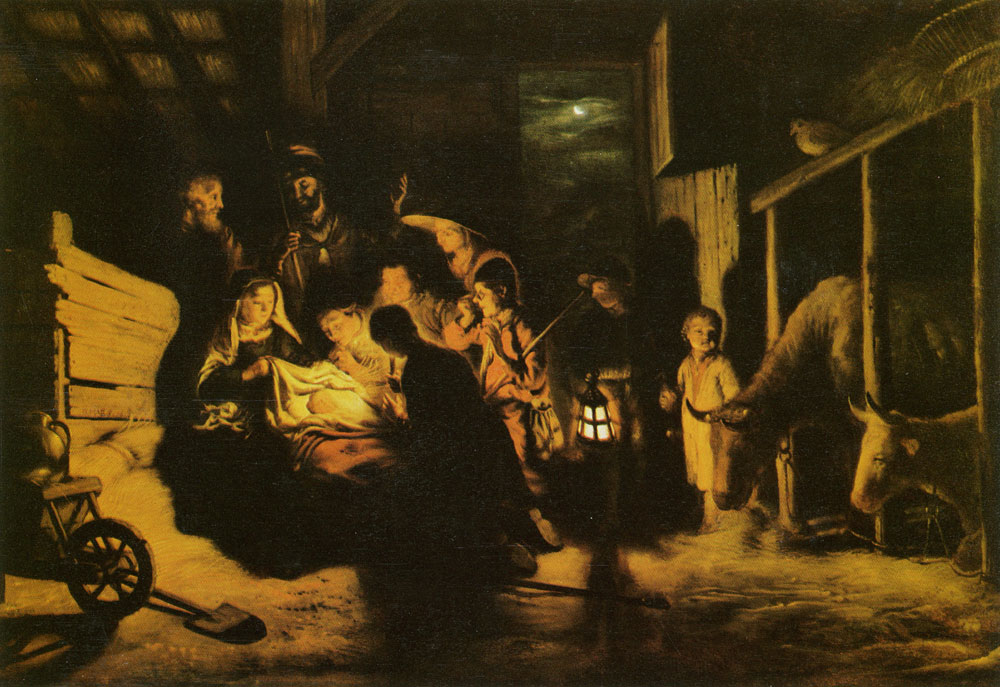 |
| Adoration of the Shepherds by Nicolaes Maes. Image from pubhist.com |
My favourite section was the fourth level which housed a lot of religious art, from models of medieval churches to stained glass which was hundreds of years old to icons and portraits of biblical figures. As was to be expected, there were a lot of paintings and representations of Jesus. I looked at them all, searching for a Jesus I could relate to, a Jesus I recognized. Most of time, Jesus was clothed in rich robes, the shadows of the folds painted with great care. The scenes of Jesus's family life were serene, depicting a leisurely day in the life of nobility, it seemed. Everywhere, Jesus was clean and muscular and, for the most part, unmarred, even on the cross. The iconic paintings were simpler, Jesus and Mary together in many of them, but even there, the simplicity was swathed in richness. Plenty of gold and fine fabrics. fluttering angels, and everyone posing perfectly to catch the light just right and show their good side. Distractions were minimized, every fold of cloth in its proper place, no screaming, squalling babies, only peace and light. It reminded me of the perfect pictures we post on Instagram, showing ourselves and our world at its best and brightest.
I am no art historian, but I am aware that portraits and icons are not photographs meant to capture the reality of everyday life. In many cases, paintings in other eras represented, and were meant to appeal to, those who commissioned them (mostly nobility or the church). Religious paintings incorporate symbolism and create their own reality to a certain extent. Nevertheless, it was troubling to me how far removed the portrayals of Jesus were from the earthy, messy stories we find in the gospels. There were a few exceptions, of course. One was the humble nativity scene by Nicolaes Maes (a student of Rembrandt) in which the stable, while not exactly dirty, includes brown cows, hay, a wheelbarrow and a shovel, and the faces of the shepherds are far from handsome. The scene comes off as ordinary and wonderful and strange all at the same time. In another room, a tiny icon of Matthew (about 3 inches tall) looking haggard and unafraid, wreathed in gold, was also a gem, easily overshadowed by the larger works, but definitely worthy of attention. There was also one painting of Jesus and Mary which caught my eye. In it he is chubby with curly blonde hair, wearing a bright red robe and clutching a sparrow. The pious expression of the mother verges on sorrow and the child seems out of place, looking longingly to the side. It unsettled me in its odd portrayal, and I liked that.
As I left the museum, I thought about all the ways we portray Jesus in our world today. Like any era, we project our own values onto our religious stories and clothe our religious figures in them. Is our Jesus wrapped in rich fabrics? Is our Jesus surrounded by pious family and friends? Is our Jesus strong and muscular, always the conqueror? Is our Jesus judging or forgiving? Is our Jesus untouchable, glowing with an unearthly glow? Is our Jesus unmarked by the scars of life? Is our Jesus always visible, the centre of every scene? Is our Jesus in clean, tidy environments, every hair in place, every person around him beautiful and successful? Is our Jesus a noble or a peasant? Is our Jesus Italian or Spanish or Caucasian or Black or Jewish? Is our Jesus in an art gallery, in a church, or in the dullness and pain of every day life?
Perhaps the most important question is, "Would I recognize Jesus if I saw him today?"
The Christ is present here and now. Do we see him?
Comments